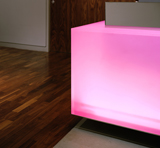Art Projects
- Labyrinth
- Phantom
- Body Of Water
- Murmur
- Reality Version 1.5
- As Above So Below
- Chandelier
- Between Now and Then
- Gathering
Design Projects
- Trading Areas
- Energy: Fuelling the Future
- Gallery of Craft and Design
- Manchester Gallery
- Shared Ground Zone
- Matrix Chambers
- Craft and Design Gallery
- Centenary Gallery
- African Worlds
- Kaleidoscope of Life
Lecturing/Research
Gallery of Craft and Design
Role: Senior Designer employed by Casson Mann the Lead Consultant Exhibition Designer
Client: Manchester Art Gallery
Site: Top Floor Athenaeum Building, MAG
Size: 600 square metres
Completed: July 2002
MAG Awards: Large Visitor Attraction of the Year: Manchester Tourism Awards 2010, Northwest Tourism Awards 2010 and Tourism Experience of the Year 2010
Michael Hopkins and Partners £35million refurbishment and expansion masterplan, between 1998 and 2002, transformed the former City Art Gallery and Athenaeum into a world-leading art gallery.
Charles Barry designed the Athenaeum building as a gentleman’s club in 1839, with the top floor theatre being added in 1870. For years the building was used as storage by the museum, but as part of the redevelopment it was proposed that the former Victorian theatre would house the Gallery of Craft and Design and once again become a public space. With the stage, seats and decades of grime removed, work began restoring the double height ornate plasterwork before the display cases, plinths and lighting could be installed within the imposing, decorative interior.
The gallery design pays homage to the host’s theatrical past: perimeter walls quietly whisper white noise from past Victorian theatrical performances, a large plinth displaying furniture is located in place of the removed theatre stage, tall showcases face the stage plinth in memory of the rows of theatre seats and new high-level lighting elements are suspended from the existing plaster ceiling bosses that once held ornate chandeliers.
Over 1,300 artefacts, from ceramics, glass and metalwork, to furniture, toys and dolls houses, and costumes and textiles are displayed against this dramatic backdrop. Artefacts are gathered within three main themes, Making, Memory and Collecting. Each theme has distinct stories that divide further into clusters of sub-stories allowing the visitor to take in the themes quickly, while also allowing them to mine more deeply for further information. The sub-story artefact displays are built around exciting key objects, such as Rachel Whiteread’s daybed, and to use a theatrical analogy, these star objects are surrounded by the less significant supporting cast objects. This multi-layered display strategy deliberately acts as a helping hand rather than a controlling one. Just as there are no choices regarding the level of detail to go into, there is no set route through the gallery, the visitor sets their own pace and chooses their own journey.

